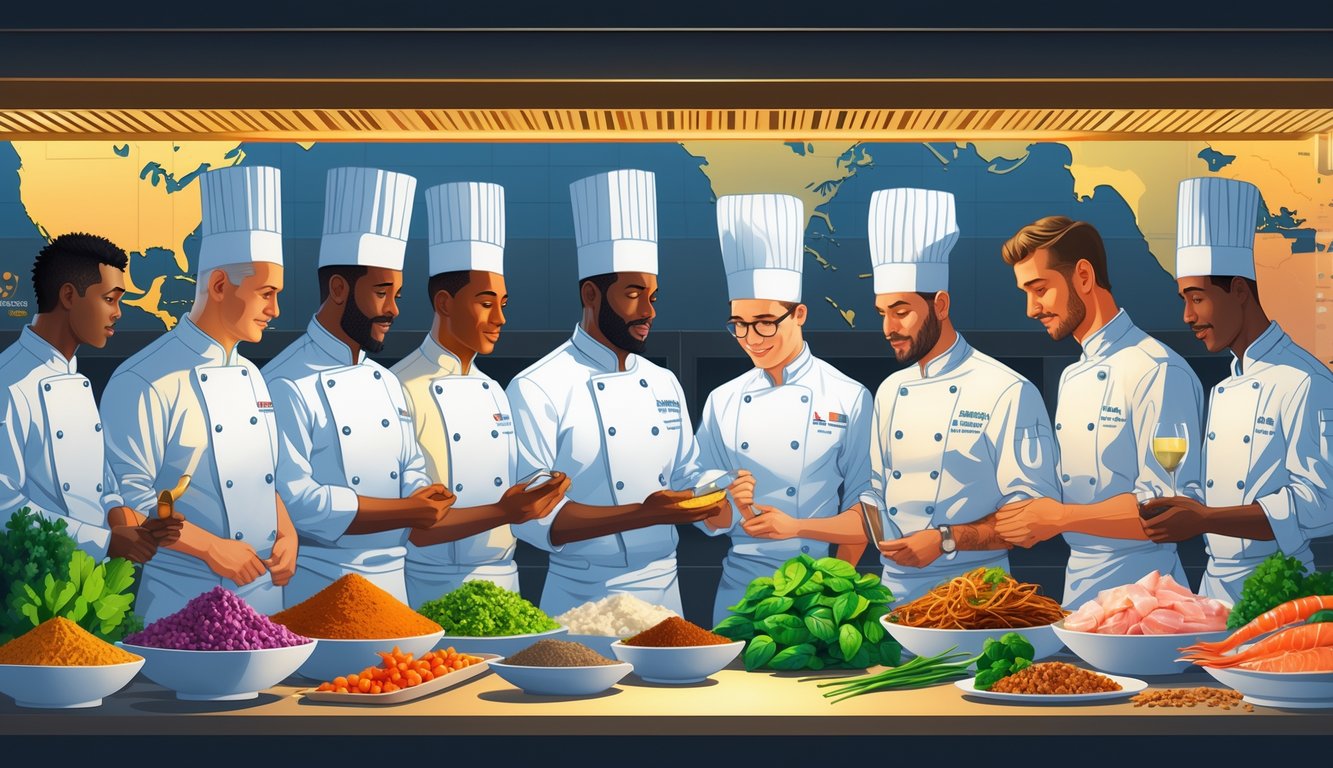
Once saw a chef clutching a bag of pea shoots at 4 a.m. in the sketchiest market I’ve ever wandered—seriously, do Michelin inspectors even care or is that just chef paranoia? Menu-writing? Overrated. The real game’s all about who sweet-talks the farmer, not who holds the knife. (Some supply guy once told me, “You can’t taste cost, only quality.” I wanted to laugh. Has he ever tasted knockoff truffle oil? Please.)
People love to talk about contracts, but it’s the relationships that actually matter. I know a chef who’ll drive three hours to some micro-dairy in the middle of nowhere just to pick up milk. He says, “If you want ordinary, just open the box.” He’s not wrong, but also—who has the time?
Honestly, the chaos behind ingredient quality? It’s not magic. It’s this weird, invisible web of texts, panic calls, and last-second weather stalking. I’ve seen prices swing so hard that one day’s menu is unrecognizable the next. And yet, someone always acts like having Yarra Valley salmon roe on hand is normal. Sourcing is not glamorous. It’s awkward emails, supplier drama, and blowing half your food budget on a berry you only vaguely remember tasting at some food show in Singapore.
The Importance of Ingredient Sourcing
Chefs—myself included, unfortunately—tend to get obsessive about sourcing. Sometimes it feels like a secret competition. Nobody wants to spill where they got that insane green Sichuan peppercorn (and yes, if it’s even slightly stale, it’s trash). It’s not just about flexing. Where your stuff comes from? It messes with your cooking, the look of the menu, even whether guests rave or just poke at the plate.
Impact on Culinary Excellence
Take beef carpaccio—if the marbling’s off, or freshness is sketchy, you’re sunk. My favorite supplier flakes all the time, so I’m constantly scrambling, hoping the next guy’s beef doesn’t taste like disappointment. Top chefs? They’re out here comparing ricotta from a tiny farm in Sicily to some Vermont wedge, and don’t get me started on their olive oil spreadsheets. Alain Ducasse once said, “A great recipe can be ruined by mediocre ingredients,” which sounds obvious, but then you see a sommelier toss out wine because the vineyard’s two miles off. Is that real? I don’t know, but I’ve seen it.
Half the time, I’m stuck in spreadsheets, tracking traceability codes. Government standards get tossed around like gospel. Then one day, the parsley smells like paint thinner and nobody can explain why. Ingredient sourcing is the backbone of flavor, but honestly, who’s rating you for your greengrocer’s phone number? Nobody. Still, can’t stop.
Influence on Menu Design
Designing a menu? Forget the TV montages. Mostly it’s me chasing produce shipments that might not even show up. Last spring, I couldn’t get ramps for a week—two other spots had already locked down the only suppliers. McKinsey says big food groups track global spend so closely that one price jump in saffron or salmon means you’re rewriting the menu before the ink’s dry. It’s not about finding the perfect tomato, it’s about rewriting recipes when that tomato suddenly costs double, or just tastes like sadness this year.
Menus don’t shape ingredients; ingredients bully menus. Risotto special vanishes? Probably a supply chain meltdown. All those little menu notes about “source may change”? That’s code for “we have no idea what’s coming next week.” If I didn’t audit suppliers every quarter, I’d be serving limp microgreens with steak tartare and hoping nobody noticed.
Connection to Customer Satisfaction
Here’s the worst part: diners notice. Like, really notice. One bad meal, and the fallout spreads faster than any marketing campaign. You ever hear, “This just didn’t taste right today,” and then realize the salmon’s from some random bargain farm? I’ve seen regulars recognize a butter switch before the servers even know. The places that keep winning repeat business? They actually document their sourcing process. Some even map it out on menus. Is that overkill? Maybe. But apparently it works.
Most five-star reviews mention freshness, not the actual dish. Sourcing transparency is the new must-have—last time I tried to sneak in a vanilla bean switch, the dessert program tanked for a month. Consistency’s boring, but it keeps people coming back. When sourcing’s on point, nobody notices. When it’s not? Everyone does.
Building Relationships With Suppliers
You’ve probably seen chefs waxing poetic about ingredients at food expos, but honestly, what saves you in the kitchen is obsessing over supplier relationships. I’m texting farmers at midnight about carrot colors, or calling a guy who swears his tahini’s better than anything in Istanbul—if you don’t listen, negotiate, and occasionally freak out, you’re toast.
Partnerships With Local Farmers
There’s always a chase. Early morning, half-dead at the farmers’ market, arguing over weirdly-shaped squash because it’s exactly what you need. Not cute. Chefs muttering, “Just give me six more trays of that red mizuna, Daniel,” while worrying about next week’s rainstorm ruining everything.
Every farmer relationship I’ve built is a mess of trust and weird trades. Sometimes they want a standing order for heritage carrots if you’ll tag them on social, which is ridiculous but fine. Farm visits feel like job reviews: “So, not rotating the buckwheat this month?” They want fair deals and predictability. I want supplies that actually show up. But then Betty brings basil instead of cilantro and the whole menu’s a scramble.
Bottom line? You need backups. No single farm delivers every time. I juggle a bunch of small producers, sometimes even rivals, and never trust “guaranteed” deliveries. Chef Matteo at Osteria d’Angelo told me, “If you’re not annoyed by your farmer at least once a month, you’re probably getting supermarket bulk.” True. Soil health, weather, city sprawl—those matter way more than whatever trend’s on Instagram.
Collaboration With Fishermen and Food Manufacturers
Fish folks are wild. 4 a.m. dockside calls, cryptic texts (“storm surge, no rockfish, sorry”). Want sustainable yellowtail? Get ready to haggle about quotas and accept zero deliveries some days. “Preferred customer” status means nothing against the ocean.
Food manufacturers? Also a headache. I’ve spent hours reading spec sheets just to dodge hidden additives—why is there maltodextrin in preserved lemon? They want big orders, but my restaurant is small potatoes. Every batch is a fight over order size, ingredient lists, and paperwork. I check USDA and FDA compliance, but still run my own tests because, honestly, I don’t trust half the claims.
Weirdest thing? Sometimes fishermen’s co-ops throw potlucks. Skip those, and you’ll never get first pick of the catch. Not exaggerating. Chef Akiko Nakamura told me her whole fish program disappeared for three months after missing a couple of those. If you’re not part of the crowd, forget it.
Supporting Local Producers
Supporting local producers isn’t about pretty Instagram shots or “farm-to-table” buzzwords. Usually, it’s awkward negotiations—my honey supplier doubled his price overnight because drought killed his hives. Local cheese guys want cash upfront. Missed produce delivery? I’m calling six backups, sometimes picking up crates myself in a rental van (don’t recommend).
Sometimes they ask you to buy ugly, leftover produce. You make it work—suddenly there’s a beet special nobody wants to prep. Staff grumbles, but what’s the alternative? Waste food? Not happening. “Sustainable sourcing” mostly means logistical nightmares and the occasional shout-out that doesn’t cover the hassle.
If a supplier’s in the local Chamber of Commerce or on the state ag census (I check, because tax perks), you might get first dibs on new stuff. But it means meetings, events, fundraisers—all while running a kitchen. Still, having a dozen local contacts is the only way I get through distributor meltdowns.



